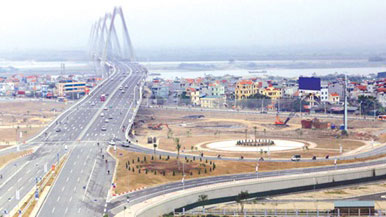Transparency key to debt management
Tighter controls, improving capital usage and making public debt transparent can ensure domestic and foreign borrowings for development and socio-economic infrastructure, said a senior official of the finance ministry.
Tran Hung Long, director of the Debt Management and External Finance Department of the finance ministry said this during a May 14 press briefing on enhancing public debt management organised by the Ministry of Finance. He said the ministry needed to clarify on two groups of issues on public debt in a clear and transparent manner.
The first group would include loans, control of the government's public debt and national public debt safety. To control these issues, the government, National Assembly, relevant ministries and agencies have made every effort required to make domestic and foreign loans transparent.
A series of laws on the state budget, tendering and investment focussed on public debt control and all institutions and policies have been working towards tightening public debt.
The Ministry of Planning and Investment (MPI) has promptly revised the Decree 38 on ODA management, while the Ministry of Finance has nearly completed the projects to be submitted to the government to enhance lending to local governments via finance institutions to minimise financial pressures on the State.
 |
In addition, the finance ministry has also urgently controlled debts and reviewed risks of debts so as to restructure public debts.
The second group will consist of those who are loan users. The loan users include ministries, local governments, project owners and every economic sector. The problem is to understand how borrowings are used by the borrowers, Long said.
The Government Directive dated February 14, 2015 was aimed at enhancing transparency and conducting strict management of public debts. He added that all ministries, project owners and economic sectors have been making utmost efforts with the government to achieve maximum efficiency.
He said that in the current context state-run enterprises were allocated investment capital and they must take full responsibilities for their loans. By doing so, the state-run businesses should not be included in the public debt.
According to the finance ministry's report, in 2014 the country's public debt for development and socio-economic infrastructure reached VND627 trillion (US$29 billion) of which more than 98% of loans have been channelled directly to infrastructure projects. The government has taken the initiative of paying the debt on time and ensuring the safety of national finances.
The direct payment of the government reached 13.8% last year and it is expected to reach 16.1% this year. Under the regulation, it is not allowed to exceed 25%.
The finance ministry reported that public debt still posed some limitations such as a sharp increase, unstable structure and the use of short-term loans for long-term investment, which imposed great pressure on payments.
Furthermore, the limitations are also attributed to the haphazard utilisation of loans and inadequate implementation of investment projects with regard to the appraisal, approval and contractor selection and land clearance as well.
To gradually overcome the shortcomings and limitations, the Directive on strengthening the management and improving efficiency of public debt is mainly focussed on the specific tasks assigned to ministries, branches and localities with a view to conducting comprehensive solutions on management of public debt, especially new loans.

